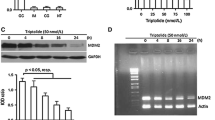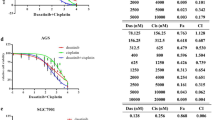Abstract
To clarify effective chemotherapeutic regimens against cancer, we examined the effects of glycerol on apoptosis induced by CDDP treatment using cultured human cancer cells (in vitro) and transplanted tumor in mice (in vivo). Human tongue cell carcinoma (SAS) cells transfected with mutated p53 gene (SAS/mp53) showed CDDP-resistance compared with the cells with neo control gene (SAS/neo). When those cultured cells were pre-treated with glycerol, CDDP-induced apoptosis was enhanced by glycerol in SAS/mp53 cells but not in SAS/neo cells.
In tumor-transplanted mice, the glycerol treatment to tumors enhanced growth delay induced by CDDP in mp53 tumors transplanted with SAS/mp53 cells, but not in wtp53 tumors transplanted with SAS/neo cells. When transplanted tumors were treated with CDDP alone, the cells positive for active caspase-3, 85kDa PARP and apoptosis were observed by immunohistochemical staining in wtp53 tumors but not in mp53 tumors. When the tumors were treated with CDDP combined with glycerol, positive cells were observed not only in wtp53 tumors but also in mp53 tumors. These results showed that the CDDP-induced growth inhibition of the tumors is p53-dependent and that the enhanced growth delay by glycerol may be due to the increased apoptosis. Glycerol might be available for cancer chemotherapy in patients with m{p53} tumors.
Similar content being viewed by others
References
Caelles C, Helmberg A, Karin M. p 53-dependent apoptosis in the absence of transcriptional activation of p 53-target genes. Nature 1994; 370: 220–223.
Dulic V, Kaufmann WK, Wilson SJ, et al. p 53-dependent inhibition of cyclin-dependent kinase activities in human fibroblasts during radiation-induced G1 arrest. Cell 1994; 76: 1013–1023.
El-Deiry WS, Harper JW, O'Connor PM, et al. WAF1/CIP1 is induced in p 53-mediated G1 arrest and apoptosis. Cancer Res 1994; 54: 1169–1174.
Waga S, Hannon GJ, Beach D, Stillman B. The p21 inhibitor of cyclin-dependent kinases controls DNA replication by interaction with PCNA. Nature 1994; 369: 574–577.
Lowe SW. Cancer therapy and p 53. Curr Opin Oncol 1995; 7: 547–553.
Lowe SW, Ruley HE, Jacks T, Housman DE. p 53-dependent apoptosis modulates the cytotoxicity of anticancer agents. Cell 1993; 74: 957–967.
El-Deiry WS, Tokino T, Velculescu VE, et al. WAF1, a potential mediator of p 53 tumor suppression. Cell 1993; 75: 817–825.
Polyak K, Xia Y, Zweier JL, Kinzler KW, Vogelstein B. A model for p 53-induced apoptosis. Nature 1997; 389: 300–305.
El-Deiry WS. The role of p 53 inchemosensitivity and ra-diosensitivity. Oncogene 2003; 22: 7486–7495.
Ohnishi K, Ota I, Takahashi A, Ohnishi T. Glycerol restores p 53-dependent radiosensitivity of human head and neck cancer cell bearing mutant p 53. Br J Cancer 2000; 83: 1735–1739.
Ota I, Ohnishi K, Takahashi A, et al. Transfection with mutant p 53 gene inhibits heat-induced apoptosis in a head and neck cell line of human squamous cell carcinoma. Int J Radiat Oncol Biol Phys 2000; 47: 495–501.
Takahashi A. Pre-irradiation at a low dose-rate blunted p 53 response. J Radiat Res 2000; 43: 1–9.
Ohnishi T, Matsumoto H, Wang X, Takahashi A, Tamamoto T, Ohnishi K. Restoration by glycerol of p 53-dependent apoptosis in cells bearing the mutant p 53 gene. Int J Radiat Biol 1999; 75: 1095–1098.
Bicher HI, Hetzel FW, Sandhu TS, et al. Effects of hyperthermia of normal and tumor microenvironment. Radiol 1980; 137: 523–530.
Rhee JG, Kim TH, Levitt SH, Song CW. Changes in acidity of mouse tumor by hyperthermia. Int J Radiat Oncol Biol Phys 1984; 10: 393–399.
Yasumoto J, Imai Y, Takahashi A, et al. Analysis of apoptosis-related gene expression after X-ray irradiation in human tongue squamous cell carcinoma cells harboring wild-type or mutated p 53 gene. J Radiat Res 2003; 44: 41–45.
Asakawa I, Yoshimura H, Takahashi A, et al. Radiation-induced growth inhibition in transplanted human tongue carcinomas with different p 53 gene status. Anticancer Res 2003; 22: 2037–2043.
Takahashi A, Ota I, Tamamoto T, et al. p 53-dependent hyperthermic enhancement of tumor growth inhibition by X-ray or carbon-ion beam irradiation. Int J Hyperthermia 2003; 19: 145–153.
Takahashi A, Asakawa I, Yuki K, et al. Radiation-induced apoptosis in the scid mouse spleen after low dose-rate irradiation. Int J Radiat Biol 2002; 78: 689–693.
Kanata H, Yane K, Ota I, et al. CDDP induces p 53-dependent apoptosis in tongue cancer cells. Int J Oncol 2000; 17: 513–517.
Kern SE, Pietenpol JA, Thiagalingam S, Seymour A, Kinzler KW, Vogelstein B. Oncogenic forms of p 53 inhibit p 53-regulated gene expression. Science 1992; 256: 827–830.
Unger T, Nau MM, Segal S, Minna JD. p 53: A transdominant regulator of transcription whose function is ablated by mutations occurring in human cancer. EMBO J 1992; 11: 1383–1390.
Matsumoto H, Takahashi A, Wang X, Ohnishi K, Ohnishi T. Transfection of p 53-knockout mouse fibroblasts with wild-type p 53 increases the thermosensitivity and stimulates apoptosis induced by heat stress. Int J Radiat Oncol Biol Phys 1997; 38: 1089–1095.
Takahashi A. Different inducibility of radiation-or heat-induced p 53-dependent apoptosis after acute or chronic irradiation in human cultured squamous cell carcinoma cells. Int J Radiat Biol 2001; 77: 215–224.
Stennicke HR, Salvesen GS. Catalytic properties of the caspases. Cell Death Different 1999; 6: 1054–1059.
Kaufmann SH, Desnoyers S, Ottaviano Y, Davidson NE, Poirier GG. Specific proteolytic cleavage of poly (ADP-ribose) polymerase: An early marker of chemotherapy-induced apoptosis. Cancer Res 1993; 53: 3976–3985.
Ohnishi T, Ohnishi K, Wang X, Takahashi A, Okaichi K. Restoration of mutant TP53 to normal TP53 function by glycerol as a chemical chaperone. Radiat Res 1999; 151: 498–500.
Ohnishi T, Ohnishi K, Takahashi A. Glycerol restores heat-induced p 53-dependent apoptosis of human glioblastoma cells bearing mutant p 53. BMC Biotechnol 2002; 2:6.
Ohnishi K, Ota I, Yane K, et al. Glycerol as a chemical chaperone enhances radiation-induced apoptosis in anaplastic thyroid carcinoma cells. Mol Cancer 2002; 1:4.
Author information
Authors and Affiliations
Rights and permissions
About this article
Cite this article
Yuki, K., Takahashi, A., Ota, I. et al. Sensitization by glycerol for CDDP-therapy against human cultured cancer cells and tumors bearing mutated p53 gene. Apoptosis 9, 853–859 (2004). https://doi.org/10.1023/B:APPT.0000045795.21285.a1
Issue Date:
DOI: https://doi.org/10.1023/B:APPT.0000045795.21285.a1




